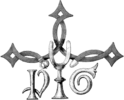Hinckaert knot
| Hinckaert knot | ||||||||
|---|---|---|---|---|---|---|---|---|
 | ||||||||
| The Hinckaert badge. | ||||||||
| Information | ||||||||
| Family | Hinckaert family | |||||||
| Region | Netherlands | |||||||
| ||||||||
The Hinckaert knot, a type of decorative unknot, is a heraldic knot used primarily in Dutch heraldry. It is most notable for its appearance on the Hinckaert family heraldic badge, where a semi-angular form is used as canting arms, a common practice with heraldic badges.
The name "Hinckaert" is delineated as a derivation of hincken, "to limp", in the badge. Hence the center crutch, and the buckle on the knot, implying that it is a strap used to attach the crutch to the leg.[1] The dexter "P" and sinister "G" are traditionally translated as standing for Philip (Hinckaert), with whom the knot originated, and his wife, née Gasparine.[1]
.png)
A portrait of Philip Hinckaert (kneeling). In the background the wall is diapered in the Hinckaert knot.
References
This article is issued from Wikipedia - version of the 3/14/2016. The text is available under the Creative Commons Attribution/Share Alike but additional terms may apply for the media files.
